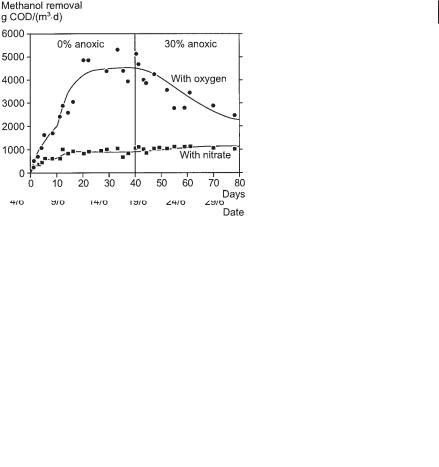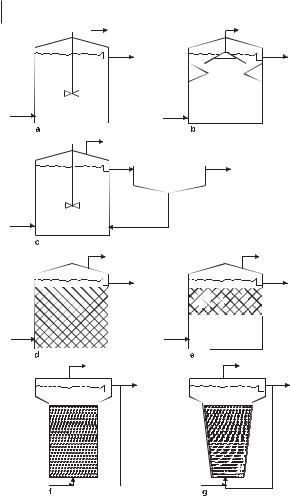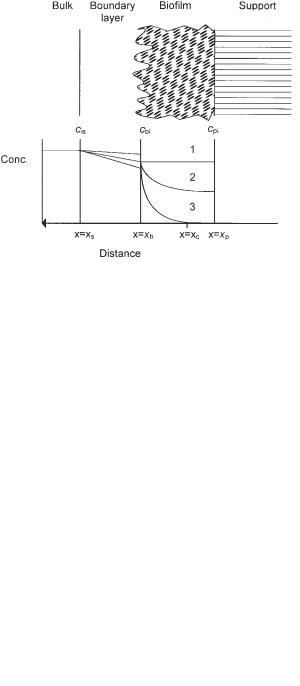
Environmental Biotechnology - Jordening and Winter
.pdf
4.9 Use of Models 131
more dynamic the data for calibration, the better the calibration will be, and the greater the chance will be for the model to respond correctly to situations outside the range of those used in the calibration. Many treatment plants have only small dynamic changes. For such plants, single dynamic events (overloading, mechanic breakdown, snow melt, etc.) are excellent for calibration purposes.
4.8
Computer Programs
Several computer programs that implement various models exist, and many include one or more of the models in the ASM family. Table 4.5 gives a short overview.
4.9
Use of Models
Models can be used for many purposes. An important field is control of treatment plants, for which it is often possible to use simplified models. Complex processes, like nitrification– denitrification combined with biological phosphorous removal and external carbon source addition, can make it necessary to use even more complex models than those in the ASM family (Meinholt et al., 1998).
Optimizing the operation of a treatment plant is another use for models. Figure 4.4 shows a model calculation for a treatment plant that receives varying loads of ammonia from the sludge treatment. This often creates a problem with overload of the nitrification process, resulting in breakthrough of ammonia peaks into the effluent from the plant. A model calculation can help find the optimal operational strategy for handling ammonia-rich sidestreams.
Table 4.5. Selected simulation programs for activated sludge plants.
Program |
Models Included |
Characteristics |
|
|
|
ASIM |
ASM1, ASM2, ASM3 |
simple program, allows for quick modeling |
EFOR |
ASM1, ASM2 |
program with a detailed wastewater calibration model, |
|
|
in which available data (including BOD) is used for cal- |
|
|
culation of both raw and treated wastewater composi- |
|
|
tion; choice between various settler models |
GPX |
ASM1, ASM2, etc. |
program in which different models can be selected for |
|
|
the simulation of both biology and settling |
SIMBA |
ASM1, ASM2 |
program widely used in the Netherlands and Germany |
based on |
|
|
Matlab- |
|
|
Simulink |
|
|
|
|
|

132 4 Modeling of Aerobic Wastewater Treatment Processes
Use of ASM1 for modeling effluent variations for ammonia dynamically loaded with ammonia-rich supernatant (Gujer, 1985).
Figure 4.5 shows a model calculation with ASM1 in relation to startup of a nitrifying activated sludge treatment process. The calculations are made to evaluate the possible effect of inoculation with nitrifying biomass. The results show that the inoculation should have no significant impact on the startup.
Figure 4.6 shows a model calculation of a process for denitrification with methanol. The process has an aerobic and an anoxic tank. By using two heterotrophic populations with different growth characteristics during modeling, a result is obtained that explains the differences in methanol removal rate. If the process is run solely aerobically for a period, the group of organisms that, under aerobic conditions, metabolizes methanol quickly will increase. This group has a slow methanol conversion rate under anoxic conditions. In the second part of the experiment, from day 40 onward, the process is operated with 30% anoxic reaction time and 70% aerobic reaction time. Under these operational conditions, the other group of organisms will dominate, resulting in higher methanol conversion rates under anoxic conditions.

References 133
Fig. 4.5 Model calculation of startup of an activated sludge process with and without inoculation with nitrifying organisms (Finnson, 1994).
Fig. 4.6 Modeling denitrification rate in the presence of methanol under varying operational conditions in an activated sludge process (Purtschert and Gujer, 1999).
References
Finnson, A., Computer simulations of fullscale activated sludge processes. Thesis, Kungl. Tekniska Högskolen, Department of Water Resources Engineering (1994).
Gujer, W., Ein dynamisches Modell für die Simulation von komplexen Belebtschlammverfahren. Dübendorf, Switzerland 1985: ERWAG.
Gujer, W., Henze, M., Activated sludge modelling and simulation, Water Sci. Technol. 1991, 23, 1011–1023.
Gujer, W., Henze, M., Loosdrecht, M., Mino, T., Activated sludge model no. 3, Water Sci. Technol. 1999, 3(1), 183–193.
Henze, M., Characterization of wastewater for modelling of activated sludge processes,
Water Sci. Technol. 1992, 25(6), 1–15.
Henze, M., Grady, C. P. L., Gujer, W., Marais, G. v. R., Matsuo, T., Activated-Sludge Model No. 1, IAWPRC Scientific and Technical Reports, No. 1. London 1987: IAWPRC.
Henze, M., Gujer, W., Mino, T., Matsuo, T., Wentzel, M. C., Marais, G. v. R., Activated Sludge Model No. 2, IAWQ Scientific and Technical Reports, No. 3. London 1995: IAWQ.
Henze, M., Harremoës, P., la Cour Jansen, J., Arvin, E., Wastewater Treatment: Biological and Chemical Processes, 2nd Edn. Berlin 1997: Springer-Verlag.
Meinholt, J., Arnold, E., Isaacs, S., Pedersen, H. R., Henze, M., Effect of continuous addition of an organic substrate to the anox phase on biological phosphorus removal, Water Sci. Technol. 1988, 38(1), 97–105.

134 4 Modeling of Aerobic Wastewater Treatment Processes
Purtschert, I., Gujer, W., Population dynamics by methanol addition in denitrifying waste water treatment plants, Water Sci. Technol. 1999, 39(1), 43–50.
Rehm, H.-J., Reed, G., Pühler, A., Stadler, P., Biotechnology 2nd Edn., Vol. 4, pp. 407– 439. Weinheim 1991: VCH.
Roeleveld, P. J., Kruit, J., Richtlinien für die Charakterisierung von Abwasser in den Niederlanden, Korrespondenz Abwasser 1998, 45, 465–468.

135
5
High-rate Anaerobic Wastewater Treatment
Hans-Joachim Jördening and Klaus Buchholz
5.1 Introduction
Anaerobic wastewater treatment is a very old method of water purification. The Sumerians were already familiar with this method of wastewater purification. The first full-scale application of the anaerobic treatment of domestic wastewater is described for the 1860s (McCarty, 2001).
Anaerobic wastewater treatment has some advantages in comparison to aerobic treatment. The specific productivity of an anaerobic system is much higher and the engineering is simple. Whereas much energy is needed for aeration in aerobic wastewater treatment plants, anaerobic treatment produces energy in the form of usable biogas. Anaerobic treatment produces only low amounts of excess biomass (5% on COD reduction in comparison to nearly 30%–50% in aerobic wastewater treatment) and the nutrient requirements are therefore small compared with aerobic treatment. On the other hand, this also means that the growth of anaerobic bacteria is slow, and for this reason in particular the start-up of an anaerobic plant is slow. Anaerobically treated water usually cannot be released directly into the environment. The COD concentration in the effluent is usually not as low as is achievable with aerobic plants and is often odorous. For this reason high-loaded wastewaters are often treated by a combination of anaerobic and aerobic treatment. The second (aerobic) step is then, if necessary, designed also for N-elimination.
Anaerobic treatment of wastewaters includes acid formation and methane formation, which differ significantly in terms of nutrient needs, growth kinetics, and sensitivity to environmental conditions (Demirel and Yenigün, 2002). Therefore, these two steps are preferentially separated physically. For many industrial wastewaters and hydraulic retention times (HRT) that are not too short, acid formation can easily be done without specific installations for bacteria retention or recycling, whereas these procedures are absolutely necessary for methane formation.
Figure 5.1 shows some basic types of reactor for methane formation.
Environmental Biotechnology. Concepts and Applications. Edited by H.-J. Jördening and J. Winter Copyright © 2005 WILEY-VCH Verlag GmbH & Co. KGaA, Weinheim
ISBN: 3-527-30585-8

136 5 High-rate Anaerobic Wastewater Treatment
Reactor systems for anaerobic wastewater treatment.
a, Completely stirred tank reactor; b, upflow anaerobic sludge blanket; c, contact process; d, fixed film stationary bed; e, combination of a and d; f, fluidized bed; g, tapered bed.
The classical digester or completely stirred tank reactor (CSTR) (Fig. 5.1a) without biomass retention is hardly used except in the treatment of sewage sludge. Industrial wastewater treatment always aims to be highly productive, and for that purpose, high concentrations of the biocatalyst, as is possible with the reactor systems shown in Figure 5.1b–g, are required.
The most widely used system worldwide is the upflow anaerobic sludge blanket (UASB) (Fig. 5.1b) (McCarty, 2002). The incoming wastewater is equally distributed over the cross section by a system of tubes. At low superficial upflow velocities (1–2 m h–1) the wastewater flows vertically through a sludge bed. A three-phase sep-

5.1 Introduction 137
aration unit, which prevents disintegration of the sludge pellets, is integrated in the upper part of the reactor. A disadvantage of this system is the limited knowledge concerning the formation of sludge pellets. These pellets are essential for the success of the system, but are not always formed with every wastewater. To avoid long times for start up, it is desirable to ‘seed’ new plants with sludge pellets from existing plants treating similar wastewaters. The productivity lies in the range of 10–15 kg m–3 d–1 COD-degradation.
The so-called contact process (Fig. 5.1c) includes a CSTR and an external device for separation and recycling of anaerobic bacteria. For the separation, settling tanks or a lamella clarifier are used. Bacterial aggregates with adhering biogas bubbles cannot be held back by these methods. Therefore, a degasser is installed between the anaerobic reactor and the settling unit. Furthermore, a reaction in the settling unit has to be avoided, which can be achieved by low COD concentrations or a decrease in temperature. COD degradation in the whole plant (including the settling unit) ranges from 3 to 6 kg m–3 d–1. An interesting report concerning this process and its application is given by Kroiss and Svardal (1999).
Fixedand fluidized-bed reactors offer the advantage of high-load systems, requiring much less volume and space, and hence less investment than conventional systems. Furthermore, these systems tend to operate more stably under transient conditions such as fluctuations in substrates and pH. For these reasons, this chapter deals especially with these modern systems for high-rate anaerobic wastewater treatment.
The advantages mentioned are of interest to those industries that produce large amounts and/or highly concentrated wastewaters, notably the food, paper and pulp industries. Several fixed-film system reactor configurations are shown schematically in Figure 5.1d–g. Although most fixed-film systems can be associated with this scheme, the number of variations is high as regards the flow mode (upor downflow), the fluid distribution system at the reactor inlet, the support material and expansion (for fluidized beds), and the configuration of the reactor outlet (gas–liquid– support separation). Recycling is in general provided for dilution of substrate and fluidization.
Several problems, however, have hindered the application of these systems. These are longer startup times if no specific inoculum is available, requirement for a more sophisticated process control, and the cost of the support material (Weiland and Rozzi, 1991). Appropriate solutions are, in principle, available to overcome these problems.
Nevertheless, there has been considerable progress in application as a result of research and pilot plant investigations, as well as data published on industrial systems. A large amount of literature has accumulated, mainly over the last two decades, so that only part of it can be mentioned here. This chapter concentrates on basic principles of anaerobic fixedand fluidized-bed systems and on recent experience accumulated on the laboratory, pilot, and industrial scales. One should, however, keep in mind that industrial applications must be based on pilot plant experience at the factory site for every new substrate or new source of wastewater or any specific problem.

138 5 High-rate Anaerobic Wastewater Treatment
A very broad and most successful application of high-performance anaerobic treatment in fixedand fluidized-bed reactors relates to wastewater from industries based on agricultural and forestry products, which typically have high concentrations of organic substrates readily degraded by anaerobic bacteria (AustermannHaun et al., 1993). They may result from raw material washing procedures, blanching, extraction, fermentation, or enzyme processing. Original substrates are usually carbohydrates, such as sugar, starch, cellulose and hemicellulose proteins, and fats, which readily undergo bacterial degradation to fatty acids, mainly acetic, propionic, butyric, and lactic acids. The majority of installations are in the potato, starch and sugar industries, in fruit, vegetable, and meat processing, in cheese, yeast, alcohol, citric acid, and pectin manufacturing and in the paper and pulp industries. The concentrations of substrates are typically in the range 5–50 kg (COD) m–3, which are diluted by recirculation (loop reactor) to less than 2 kg (COD) m–3.
In some countries, such as China, systems for the treatment of domestic sewage also play a major role (Yi-Zhang and Li-Bin, 1988). In the chemical and petrochemical industries, the implementation of anaerobic treatment plants for complex wastewaters started in the 1990s (Macarie, 2001). Furthermore, considerable efforts were made also to treat inhibitory or toxic substances. Thus, cyanide-, formaldehyde-, ammonium-, nickeland sulfide-containing wastewaters were investigated, and it was shown that methanogens can accommodate to rather high concentrations of such toxins, depending on the retention time (Parkin and Speece, 1983). Furthermore, organochlorine compounds in kraft bleaching effluents and in pesticide-con- taining water, including chloroform, chlorophenols, chlorocatechols and similar compounds, as well as chlorinated resin acids, could be treated to the stage of mineralization by adapted biofilms (Salkinoja-Salonen et al., 1983). These positive results were obtained on the laboratory scale. The degradation of furfural in sulfite evaporator condensate can proceed to a conversion of about 90% (Ney et al., 1989).
5.2
Basic Principles
Reactors are tubes with fixed bed internals or fluidized suspended particles, which serve as a support for biomass immobilization. The dimensions range from 10 to 500 m3 with a ratio of height to diameter of 1–5. In general, an external loop recycles part of the effluent to the inlet, where mixing with the wastewater provides for its dilution to noninhibitory substrate concentrations and pH. Rarely, tapered beds have been used; most of the fluidized beds are provided with a settling zone with a larger diameter at the top of the reactor.
5.2.1
Biofilm Formation
The basis for the use of packed-bed and fluidized-bed systems is the immobilization of bacteria on solid surfaces. Many species of bacteria (and other microorganisms) have the ability to adhere to supporting matrices.

5.2 Basic Principles 139
Although immobilized bacteria have been used in aerobic wastewater treatment since the beginning of the 20. century, the application of these systems to anaerobic wastewater treatment is relatively new.
The fundamentals of bacterial adhesion to and growth on solid surfaces are discussed by Wingender and Flemming (1999). Here, only some aspects concerning anaerobic fixed films are considered. The preconditioning of solid surfaces is influenced by both environmental conditions (e.g. pH, temperature) and the surface itself (e.g. hydrophobicity, surface charge). The initial anaerobic biofilm attachment can be improved by the addition of cationic polymers (Stronach et al., 1987; DiazBaez, 1988) or slime-producing bacteria (Diaz-Baez, 1988), but the biofilm development is worse than in systems lacking these components. Jördening (1987) reported a positive effect resulting from supplementation of calcium.
The primary adhesion of cells to the surface is due to hydrogen bonds, van der Waals forces, and/or electrostatic interactions. This reversible form of adhesion can become irreversible due to the production of exopolymeric substances (EPS), which act as a glue (Wingender and Flemming, 1999). Experiments on the first steps of the formation of anaerobic biofilms have given different results: although Sanchez et al. (1996) found facultative anaerobic bacteria to be primary colonizers, Sreekrishnan et al. (1991) observed that biofilm formation was initiated by methanogenic bacteria.
After a lag phase, which seems to be necessary for adaptation of the microorganisms to the new environment, exponential growth of bacteria begins. The growth rate is mainly determined by substrate transport and temperature (Heijnen et al., 1986).
5.2.2
Biofilm Characteristics
In view of the wide range of possible biofilm compositions, it is obvious that biofilm thickness does not correspond to the activity of the biocatalyst. Hoehn (1970) reported that the highest biofilm density occurs when the total biofilm thickness corresponds to the active biofilm thickness, i.e., the substrate-penetrated part of the biofilm.
5.2.3
Kinetics and Mass Transfer
The reaction kinetics for any process changes with immobilization of the catalyst. In general, the following mass transfer processes have to be considered:
1.transport of substrate from the fluid to the surface of the support through the boundary layer (external mass transfer)
2.transport of substrate from the surface into the pores of the biocatalyst
3.reaction
4, 5. transport of products in the opposite direction of steps 1 and 2
The transport of substrates and products through the reactor is related to the hydrodynamic characteristics of the system and is generally much faster than steps 2–4. Mass transfer is mostly reduced by diffusion limitation.

140 5 High-rate Anaerobic Wastewater Treatment
Depending on the mode of limitation, one can distinguish between film diffusion and pore diffusion and combined limited systems. Figure 5.2 schematically illustrates the resulting substrate profiles.
For the description of the activity changes resulting from immobilization, an effectiveness factor is used, defined as
observed reaction rate
ç = |
|
(1) |
|
reaction rate in bulk liquid conditions
5.2.3.1 External Mass Transfer
In passing a solid surface, the fluid characteristics change from turbulent to laminar flow and produce a boundary layer around the surface. The flux j1 through the boundary layer is equal to the mass transfer coefficient ke and the concentration gradient from the outer shell cis to the particle surface cbi:
j1 = ke (cis – cbi) |
(2) |
An analytical solution for ke can be given only for the ideal case of a single particle at infinite dilution. The mass transfer coefficient is given by
ke = 2 |
D |
(3) |
|
dñ |
|||
|
|
with D-diffusion coefficient and dp-particle diameter.
Fig. 5.2 Substrate concentration profiles at an immobilized biocatalyst surface. 1, Reaction rate-controlled system; 2, combination of reaction rateand diffusion-controlled system; 3, diffusioncontrolled system.
